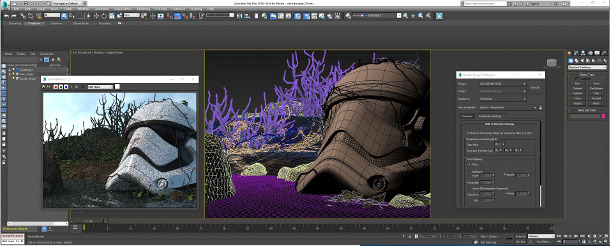AMD releases FireRender for 3ds Max

Originally posted on 12 August 2015. Scroll down for news of the public release.
AMD has unveiled the 3ds Max version of FireRender, its OpenCL-based GPU renderer, at Siggraph 2015.
First demoed at Siggraph 2014 in its original Maya integration, the new 3ds Max edition has been developed in collaboration with Corona Renderer developer Render Legion.
Functionality and system requirements
FireRender is an unbiased path tracing renderer, and includes a native physically based material system.
Unlike the majority of GPU-accelerated engines currently on the market, it’s based on OpenCL so – although intended for use with AMD’s FirePro workstation GPUs – it should work with any card that supports OpenCL 1.2.
FireRender also provides a CPU backend, so the renderer can run on any combination of CPUs and GPUs.
As well as Max’s native materials, FireRender 3ds Max plugin supports Corona Renderer materials out of the box, as well as V-Ray materials via Corona’s material converter.
Updated 14 June 2016: According to the online documentation accompanying the plugin’s release, only 3ds Max’s Standard material is fully supported. There’s no mention of Corona materials.
According to AMD, “many of [3ds Max’s native] materials simulate a physical effect on the surface of an object which is not required when using a physically based material and raytracing renderer”.
Instead, the plugin ships with its own material library.
As far as we can see, there isn’t any information about the renderer on AMD’s website yet, but the company has provided us with the following feature list:
- High-level rendering API (C-style)
- Unbiased/biased path-tracing
- State-of-the-art sampling algorithms
- Multiple importance sampling
- Many lights support
- Adaptive rendering
- Physically based materials
- Layered material support
- Standard uber-material
- Volumetrics
- Physically based camera
- Lens and sensor simulation
- Physical bokeh
- Motion blur
- Analytic and physical lights
- Point, directional, spot
- Area lights
- Image-based lighting with IS
- IES profiles support
- Incandescent material
- Physical skylight
- Post-processing filters
- Numerous image reconstruction
- Tonemapping
- Based on open technologies (OpenCL, OpenGL, OpenImageIO, OpenVDB)
In addition, FireRender’s SDK provides a C++ library designed to enable developers to integrate the engine into other DCC applications.
Updated 14 June 2016: FireRender for 3ds Max is now available in beta. (Actually, it’s been out for over a month, but we only spotted it when an email newsletter came round from AMD.)
The plugin is compatible with 3ds Max 2016 with Service Pack 3 running on Windows 7 and above. It runs on any GPU with driver support for OpenCL 1.2 and above.
Read a full list of features in FireRender for 3ds Max on AMD’s developer website
Download FireRender for 3ds Max
(Includes links to sample scenes and the material library, the online user guide and more video tutorials)
